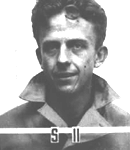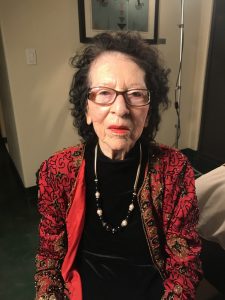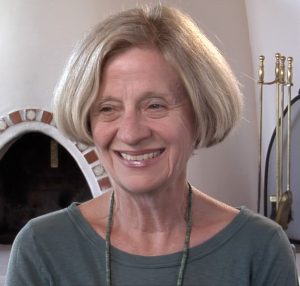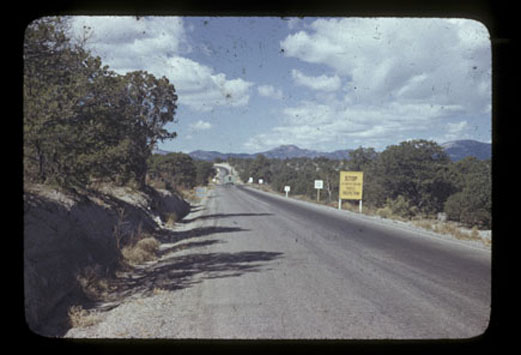David Hawkins first met J. Robert Oppenheimer when he was a graduate student at Berkeley in the late 1930s. Hawkins and Oppenheimer became good friends during their time at Berkeley and had great respect for each other. Hawkins recalled that Oppenheimer had a high opinion of David’s intelligence. “That was what he always said, ‘He’s a very intelligent young man.’ I don’t know where he got this, really. But he had great respect for me, and great personal support, as I found out later.”
In 1943, Hawkins received a phone call out of the blue from Oppenheimer. As David recalled, “That was early May. Could I come to Los Alamos the next day?” Oppenheimer offered Hawkins the job of administrative assistant. Hawkins remembered, “I was a young punk. I was just thirty, and very inexperienced. I had no idea what I was getting in for. I had no administrative experience.” Nevertheless, he accepted the job in Los Alamos and moved there with his wife Frances and their young daughter, Julie.
Life at Los Alamos
 Hawkins (right) was trained as a scientist and philosopher. He taught courses, including economics, at Berkeley. His daughter Julie described him as a “renaissance type, all different fields, something not so common today.”
Hawkins (right) was trained as a scientist and philosopher. He taught courses, including economics, at Berkeley. His daughter Julie described him as a “renaissance type, all different fields, something not so common today.”
Hawkins served as the administrative assistant to Oppenheimer at Los Alamos and helped in Oppenheimer’s laboratory. When Hawkins arrived at Los Alamos, Oppenheimer was the only person above Hawkins. As the project progressed, it became more bureaucratic and Hawkins had to report to others. In 1944 Oppenheimer offered Hawkins the job of writing the history of Los Alamos (Project Y: The Los Alamos Story).
David’s wife, Frances, was an expert in early childhood education and founded the nursery school during her stay at Los Alamos. Julie recalls, “She [Frances] was very unhappy about being there. She made some good friends while she was there, but she didn’t like working on the war. She didn’t like weapons. She wanted to get out of there. She was uncomfortable there.”
David Hawkins grew up in La Luz, New Mexico and was familiar with the Los Alamos area. He is often credited with suggesting the Trinity site as the location for the first test of the atomic weapon. Hawkins’ position as historian allowed him to attend the testing of the device, but he declined. Hawkins remembered years later, “I was disturbed by the enthusiasm many people seemed to have. They seemed to have lost sight of the grave consequences of doing this job.”
 The work at Los Alamos also impacted the lives of the communities who lived near “The Hill.” Frances Quintana (left), Julie’s babysitter, and her family were among the Hispanos who experienced this abrupt change. Frances’ first responsibility at Los Alamos was looking after Julie, although she later worked at the laboratory, taking on a variety of jobs over the years. She remembered, “We used to have a lot of fun. We used to hike, we used to play. She [Frances Hawkins] was the nicest lady, and she taught me how to sew. We used to sew together so much. Mr. Hawkins got me this job at the Technical Area. After they left, I started working there. I worked there for thirty-five years.” Julie and Frances still maintain a close relationship.
The work at Los Alamos also impacted the lives of the communities who lived near “The Hill.” Frances Quintana (left), Julie’s babysitter, and her family were among the Hispanos who experienced this abrupt change. Frances’ first responsibility at Los Alamos was looking after Julie, although she later worked at the laboratory, taking on a variety of jobs over the years. She remembered, “We used to have a lot of fun. We used to hike, we used to play. She [Frances Hawkins] was the nicest lady, and she taught me how to sew. We used to sew together so much. Mr. Hawkins got me this job at the Technical Area. After they left, I started working there. I worked there for thirty-five years.” Julie and Frances still maintain a close relationship.
Red Scare
David Hawkins left Los Alamos in 1946 for Washington D.C., and later taught philosophy at the University of Colorado-Boulder. In 1950, David and Frances Hawkins were called up by the House Un-American Activities Committee (HUAC) to testify about their connections to the Communist Party. They had joined the Communist Party while he was at Berkeley. “We were both influenced by activists at Berkeley and Stanford,” David explained. “Part of it was the development in the latter part of the Depression of really nasty kinds of vigilantism in the agricultural valleys of California, which we all got somehow involved in trying to do something about.”
David left the Party in 1940 because of the wars that were occurring overseas in Europe: “The main one had to do with the [Nazi] invasion of the Low Countries, and the French and English and American Communist Party’s inability to cope with the fact that there really was a war going on.”
Although he was never asked directly about Oppenheimer’s political affiliations, he was asked if anyone he knew was a member of the Communist Party during interrogations. David and Frances refused to answer about other people’s political memberships, citing the First and Fourth Amendments. The investigation endangered Hawkins’ job at UC-Boulder. Hawkins was a tenured professor at this point, but as his grandson Scott Fisher explains, “In a vote on his future employment, the regents of the University of Colorado split evenly, but his job was saved when one of them died.”
Later Life
 David and Frances co-founded the Mountain View Center for Environmental Education in 1970. In 1981, David was awarded a MacArthur Foundation “genius grant” as part of the first group of MacArthur Fellows. The Hawkins Center of Learning is still operating and creates projects that stray from following curriculum or textbook standards, allowing kids the freedom of exploration. David and Frances left behind a legacy of educating children, the same way they inspired their own child, Julie. Frances published two books on her teaching experiences, and on educational philosophy and methodology.
David and Frances co-founded the Mountain View Center for Environmental Education in 1970. In 1981, David was awarded a MacArthur Foundation “genius grant” as part of the first group of MacArthur Fellows. The Hawkins Center of Learning is still operating and creates projects that stray from following curriculum or textbook standards, allowing kids the freedom of exploration. David and Frances left behind a legacy of educating children, the same way they inspired their own child, Julie. Frances published two books on her teaching experiences, and on educational philosophy and methodology.
The time spent at Los Alamos had a lasting impact on all members of the family. Today, Julie (right) is an author and expert on civil society, development and democratization. She reflects on the impact of Los Alamos on her life: “I think it’s made me sensitive to moral nuance, aware of the complexity of questions that aren’t easily answered. But my father was that way. He would’ve been that way whether or not; I’m not sure it was his Los Alamos experience. But it certainly magnified that question in all of our lives.”
For further information please see these interviews:





